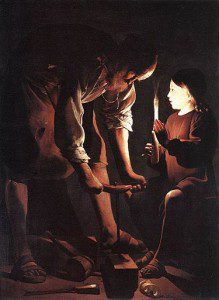Tom Nelson, pastor of metro Kansas City’s Christ Community Church and author of Work Matters: Connecting Sunday Worship to Monday Work, had plenty to tell us as we munched oversize muffins about what’s going on in Genesis 2. And it’s not, he said, what we commonly think of.
Tom argued that Genesis 2 is a story about how humans fit in as image bearers with the work of God in the world. So often preachers go right to the topic of marriage when they discuss the creation of Eve. True, the Hebrew word parah which we met in my previous post means both productivity and procreativity.
But as the Hebrew of chapter 2 unfolds–as we get used to hearing the refrain from God “good, good, good,” then “exceedingly good”–suddenly something is not good. Dissonance. “It is NOT good that man should be alone. I will make a helper fit for him.”
We often jump to the the end of the chapter. But the question for the listener should be: “A helper for WHAT?” God already created the animals before Adam, but they don’t cut it, because of the job description in 2:15 – an ox can plow, but image bearers are needed. The word “helper” (ezer) is a good word here – not a second-class assistant. When we help, we help to DO something, to accomplish a task. God creates humans male and female to be productive (and procreative) TOGETHER.
Seen in that light, Genesis 2 highlights collective collaboration. Tom commented that many single people say when they hear this: Finally someone is telling me that my life is valuable, even without marriage! The purpose of all humanity–married or single, with children or without: cultivating and keeping creation.
But further on in Genesis 3, there a disintegration. Parah is destroyed or hindered. Pain comes: the pain of birth, thorns and thistles on the parah of creativity. Yet there is still a prophecy: Noach, the comfort- bringer, will relieve the toil of our hands.
Tom gave a shout-out here to our friends at the Theology of Work Project, who have done an outstanding job publishing excellent scholarship from Genesis to Revelation showing how work is a central thread throughout the Bible. You can read more on their website–and soon, in a print commentary they are releasing in October. It’s all THERE, Tom reminded us, and we’re just now rediscovering it.
One thing we miss, Tom said, are the hidden years of Jesus. If souls are all that mattered in God’s story, Jesus would start at 12 – when he was clearly brilliant and ready. But why did God send his son to spend age 12 to 30 in acarpentry shop? “Is this not the carpenter, the technon?” The word indicates an architect, a builder, a blue-collar worker. The Son of God before the worlds began spends the majority of his time redeeming creation in a carpentry shop!
This does not diminish the cross, Christ’s substitutionary atonement . . . but it shrinks and reduces his mission without the hidden years. Many have never heard this preached. Never thought those years mattered. What does it mean that Jesus was incarnate with holy sweat on his brow, dealing with difficult customers, with economic realities, without sin? We must hear thewhole story. Some people come out of their seats hearing that, Tom said. My welding, changing diapers, blue-collar work matters?
 Tom showed us pictures from two 17th-c artists: first the Spanish artist Vasquez – Christ crucified. This Spanish painter thought of the cross , then the resurrection – that should never be lost. It’s the heart of the gospel.
Tom showed us pictures from two 17th-c artists: first the Spanish artist Vasquez – Christ crucified. This Spanish painter thought of the cross , then the resurrection – that should never be lost. It’s the heart of the gospel.
But a French painter, Latour, painted a second masterpiece – St Joseph the Carpenter. Here a young Jesus helps his earthly father Joseph in the carpentry shop. What does this picture say about God’s work ?
So: Christ Community has been hearing a new story about who humans are as workers before God. What else have they been doing to change the culture of their church? That’s where will end up this series of posts on Tom’s talk….perhaps with some ideas that reverberate into your own context as well.













